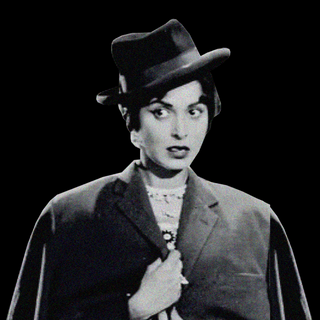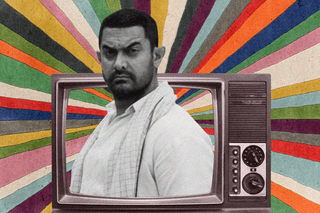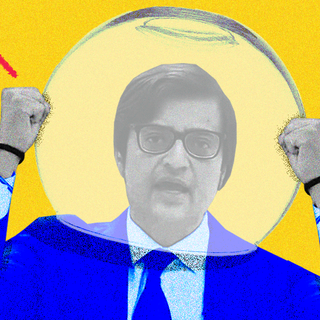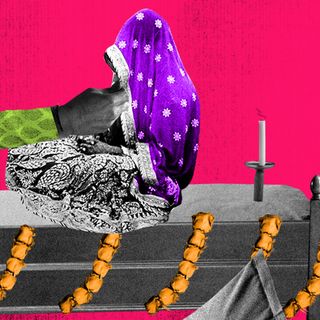
Can We Move On: From the Trope of the Male Savior Who Rescues Women From Patriarchy in ‘Woke’ Movies
It seems performative to grant male actors more screen-time and better fleshed-out characters than any of the women they are supposed to be empowering.

In Can We Move On, we revisit old tropes and question whether they have any remaining cultural relevance.
Dangal, on the edge of its release in 2016, was widely marketed as a movie about women’s empowerment. But amid the happy uproar about Bollywood starting to invest in women-centric stories, a friend pointed out to me how the movie wasn’t women-centric at all. She was right; the celebration was misguided. The movie wasn’t women-centric at all; Dangal, at its core, revolved around a cishet man, his hurt ego, and his ambitions. His daughters merely served as the means to his redemption.
The pattern behind this plot, of a man spearheading a story purportedly about women’s agency, is well etched out. Think of 2007’s Chak De India, where the women’s hockey team is guided to success by a man at the helm, played by Shahrukh Khan. Here, too, the women become a tool for Khan’s character to regain the respect he had lost.
Commenting on the phenomenon, an article asks, “Rumor has it that Akshay Kumar will be playing the role of P.V. Sindhu’s coach Pullela Gopichand in the former’s biopic… one wonders if Sindhu’s biopic will focus on her, or how her mentor battled odds to ‘make’ her a world champion?” Even 2017’s Toilet: Ek Prem Katha to 2018’s Padman to 2019’s Mission Mangal has Kumar time and again reprising the role of the ultimate uplifter of women. In fact, a ScoopWhoop article even termed him “Bollywood’s go-to man-savior.”
But he’s hardly alone. Hindi cinema has plenty of “Indian women’s savior” aspirants — perpetuating the idea that women are damsels in distress, who need rescuing. Moreover, when a movie about women’s agency and freedom orbits around a man’s journey, its very purpose is defeated. Offering male actors more screen-time and more fleshed-out characters — like all of Kumar’s characters or Aamir Khan in Dangal — ends up drawing focus away from the narratives of the very women they are supposed to be empowering. This representation seems performative at best, and a ploy to capitalize on the struggles of marginalized communities to rake in profits, at worst.
Related on The Swaddle:
The Gender Politics of ‘Dune’ Keep It From Being Truly Ahead of Its Time
Evidently, the savior trait is aimed at “rescuing” not just cis women from the shackles of patriarchy, but also extending the privilege to people from a diverse range of marginalized identities. And following in Kumar’s footsteps is Ayushmann Khurrana — an actor-singer, who is almost two decades younger than Kumar, and rather popular with India’s impressionable youth.
In January, he appeared in Chandigarh Kare Aashiqui, a movie that prided itself in championing the rights of trans people. Yet, as Sucharita Tyagi, a film critic, noted: “The script spends way too much time going about Manvinder’s [played by Khurrana] fitness journey… Why must one celebrate any of Manvinder’s sports victories, when in the film’s larger conflict, he’s not the underdog?” Tyagi wished the script focused more on showing Khurrana challenge his prejudices to overcome his transphobia. Another trajectory the writers could’ve chosen, perhaps, would be to portray the journey of the trans character. But it did neither. Instead, it chose to weave its narrative around the macho-hero’s struggles to emerge at the top of his city’s annual “masculinity contest” of sorts.
This is not to suggest that movies that try to approach social issues through the trope of the male savior don’t contribute anything to society at all. “[Chandigarh Kare Aashiqui] is ‘Trans Persons 101’ for a completely uninitiated audience in a mainstream format, and I am happy it exists,” Gazal Dhaliwal, a trans woman, who is also a screenwriter, said. Similarly, 2016’s Pink — where Amitabh Bachchan steps into the role of the male savior — started a much-needed conversation about consent in India.
But the question is: is the trope of the male savior really necessary to this end? Many believe it is. “India is a pluralistic society. We have to strike a balance… It is obvious that the downtrodden will fight for themselves, but in our country, you need to have that ‘hero’ who can fight for them,” Khurrana had said in an interview after the release of Article 15, where he strives to achieve justice for individuals caught in the intersection of both gender and caste-based hierarchies of society.
But is there truly any merit to Khurrana’s point, or is it just an excuse for men to mansplain feminism to women? Let us assume for a moment that the filmmakers who rely so generously on this male savior trope were genuinely dedicated to the cause of women’s empowerment. Let’s also assume the only way to get their points across to their audiences would be through Khan’s buffed-up body and Bachchan’s baritone — a compromise, alright. But why, then, does their dedication not stop them from reinforcing patriarchal values instead of questioning them? In Dangal, the message that was put forth was conventional feminine traits — like having long hair — make women weak. Not only that, the movie, over and over again, reinforces the idea that a man understands what’s best for his daughters than the daughters themselves — justifying his disrespect for their opinions and their right to choose how to live their lives.
Related on The Swaddle:
Not only that, when movies rely on the trope of the male savior to talk about women’s empowerment, they often end up with clichéd — if not caricaturized — representations of women as “abala naari,” or helpless woman, who are so rudderless and oblivious that they don’t even know what’s good for them. These clichéd representations are often a result of narratives being framed from a male lens — suggesting that the male savior trope we see onscreen probably plays out often in the writers’ room too, mirroring it almost. Imagine this: you’re standing in front of a mirror that’s parallely facing another mirror so you can see infinite reflections of yourself. That’s probably how the perspectives of male writers translate into the screen — perhaps, inspiring more filmmakers to replicate precisely that.
Instead, involving women in weaving narratives about the experiences of womankind can translate into more accurate depictions of their struggles, losses, and victories onscreen. Perhaps, the thumb rule for filmmakers looking to dip their toes into feminist discourse is to accord individuals with marginalized identities a significant degree of control over narratives based on their communities.
And, of course, there exist better examples of how women’s issues can be represented on screen authentically. And such movies about women’s empowerment — like English Vinglish from 2012 Queen from 2014, Dear Zindagi from 2016 Lipstick Under My Burkha from 2017, and Chhapaak and Thappad from 2020, among others — have not only contributed to the discourse significantly, but also fared well.
Pushing the idea that women need saving by a cis-het man, makes movies about women’s empowerment disempowering instead. As we step into a new decade, can we move on from the trope of the male savior in supposedly “woke” movies?
Devrupa Rakshit is an Associate Editor at The Swaddle. She is a lawyer by education, a poet by accident, a painter by shaukh, and autistic by birth. You can find her on Instagram @devruparakshit.
Related


The Buzz Cut: Govt Mouthpiece Displays Unusual Behavior by Not Interrupting Panelist, Feared Unwell
